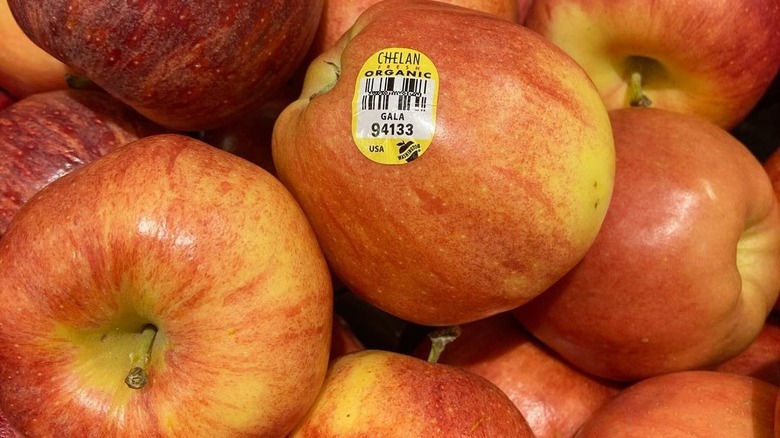The Sticker Number To Look For If You Want To Buy Organic Produce
There are a number of ways to gauge the quality of fruits and vegetables. A visual inspection is perhaps the simplest method. Bruising or discoloration, not to mention mold, are telltale signs of produce that should be avoided. Our senses of touch and smell can also be utilized to detect overly soft spots and foul odors.
But if you want to know where your produce was grown and how — meaning whether or not it's organic — there is only one surefire way to find out: Check the sticker that's attached. This sticker, which contains what is known as the price look-up code (or PLU code), does much more than simply tell checkout scanners how much fruits or vegetables cost. It also has valuable information regarding the produce's history, like whether it was organically grown or genetically modified.
These stickers are a relatively recent invention, and were first introduced by the International Federation for Produce Standards (IFPS) in 1990. Nowadays, you can type any fruit or vegetable's PLU code into the IFPS website, and it will reveal a wealth of information about its provenance. To tell if it's organic or not, however, you don't need the search feature. All you have to do is check the first number on the sticker.
Organic produce has five digits and starts with a 9
All fruits and vegetables are assigned a four or five-digit PLU code by the IFPS. Four-digit codes indicate conventional farming methods were used to grow the produce, including the use of pesticides. Organic produce, meanwhile, is always assigned a five-digit PLU code that begins with the number 9. Many organically farmed fruits and vegetables already bear this label in accordance with USDA labeling requirements, but the number 9 prefix certifies its organic status.
Genetically modified organisms (GMOs) can also be identified using PLU codes, as these products always carry stickers featuring five-digit codes prefixed with the number 8. At present, only a limited number of produce items in the U.S. meet the criteria for this label, which include corn, soybeans, squash, potatoes, papayas, apples, and pink pineapples. It's important to note that not all instances of these products are genetically modified organisms, so it's advisable to verify by examining the PLU codes.
In addition to clues about the farming methods used, IFPS codes also contain information related to the produce's variety and size. The PLU code 4133, for example, refers to small gala apples; the PLU code for the organic version (seen above) is 94133.

